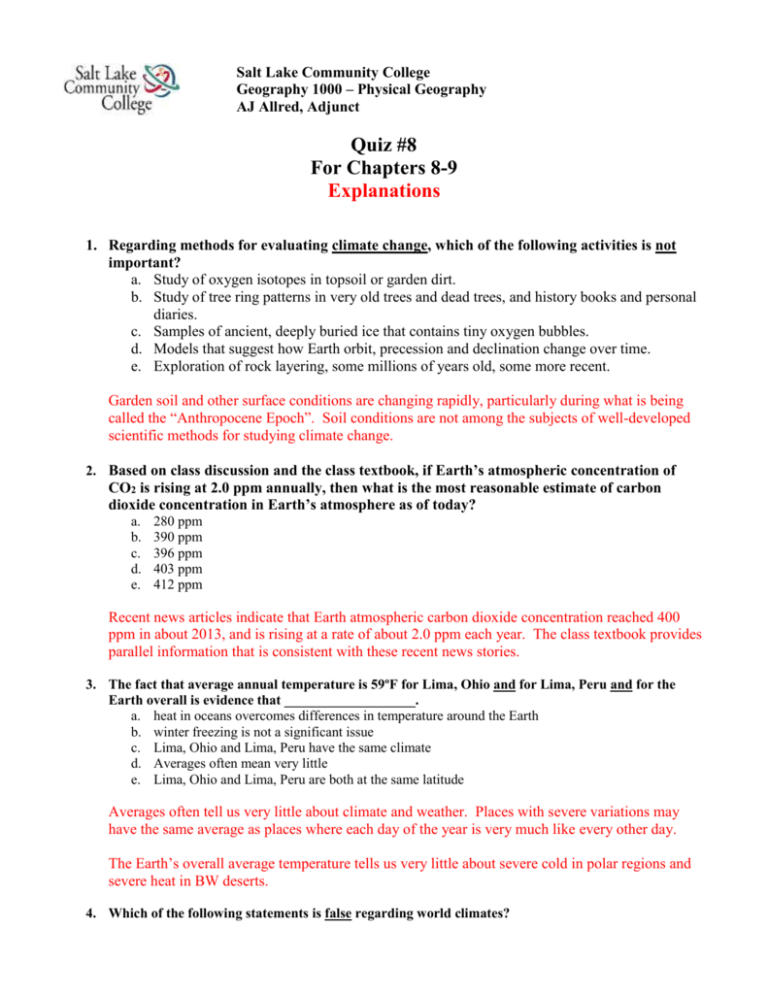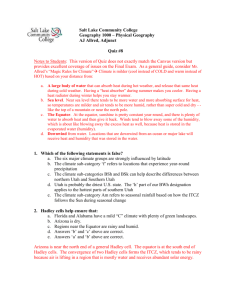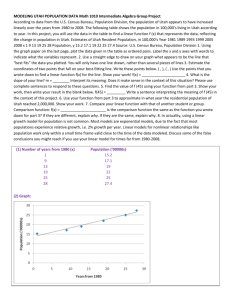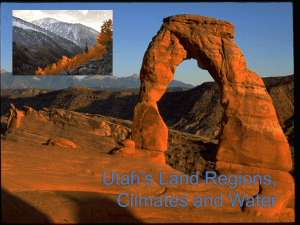Quiz #8 For Chapters 8-9 Explanations
advertisement

Salt Lake Community College Geography 1000 – Physical Geography AJ Allred, Adjunct Quiz #8 For Chapters 8-9 Explanations 1. Regarding methods for evaluating climate change, which of the following activities is not important? a. Study of oxygen isotopes in topsoil or garden dirt. b. Study of tree ring patterns in very old trees and dead trees, and history books and personal diaries. c. Samples of ancient, deeply buried ice that contains tiny oxygen bubbles. d. Models that suggest how Earth orbit, precession and declination change over time. e. Exploration of rock layering, some millions of years old, some more recent. Garden soil and other surface conditions are changing rapidly, particularly during what is being called the “Anthropocene Epoch”. Soil conditions are not among the subjects of well-developed scientific methods for studying climate change. 2. Based on class discussion and the class textbook, if Earth’s atmospheric concentration of CO2 is rising at 2.0 ppm annually, then what is the most reasonable estimate of carbon dioxide concentration in Earth’s atmosphere as of today? a. b. c. d. e. 280 ppm 390 ppm 396 ppm 403 ppm 412 ppm Recent news articles indicate that Earth atmospheric carbon dioxide concentration reached 400 ppm in about 2013, and is rising at a rate of about 2.0 ppm each year. The class textbook provides parallel information that is consistent with these recent news stories. 3. The fact that average annual temperature is 59ºF for Lima, Ohio and for Lima, Peru and for the Earth overall is evidence that ___________________. a. heat in oceans overcomes differences in temperature around the Earth b. winter freezing is not a significant issue c. Lima, Ohio and Lima, Peru have the same climate d. Averages often mean very little e. Lima, Ohio and Lima, Peru are both at the same latitude Averages often tell us very little about climate and weather. Places with severe variations may have the same average as places where each day of the year is very much like every other day. The Earth’s overall average temperature tells us very little about severe cold in polar regions and severe heat in BW deserts. 4. Which of the following statements is false regarding world climates? a. The six major climate group designations (letters A-E and H) are mostly a function of latitude. b. The sub-category ‘f’ refers to locations that experience year-round precipitation. c. The climate sub-categories ‘Sh’ and ‘Sk’ help describe differences between northern Utah and Southern Utah. d. The climate sub-category ‘m’ references monsoon conditions that ensure year-round rain in places like India. e. The climate sub-category ‘Am’ is a function of ITCZ location during the year. The ‘m’ category refers to monsoon wind shifts that often bring either persistent dryness or substantial precipitation for a season. Monsoons are about wind, but precipitation is also a typical result. Monsoon climates have distinct dry seasons and distinct rainy seasons, rather than yearround precipitation. 5. Ocean water has much more influence on weather and climate than does the relatively miniscule amount of water in the atmosphere. True ___ False ___ Only a tiny fraction of Earth’s water is in the atmosphere at any moment. However, atmospheric water has a controlling effect on Earth’s climate and weather. Atmospheric water is more important for world weather than is ocean water. 6. Hadley cells are not a key factor in ______________. a. Alabama having a mild ‘C’ climate b. persistent dry conditions in Arizona c. year-round rain at the Equator, with no significant dry season d. persistent high atmospheric pressure in ‘B’ climates e. sub-tropical deserts Hadley cell flow produces deserts at the surface where descending air is dry, and gets drier as it warms by decompression. The southeastern United States should be dry like Arizona, but is not because of trade winds that bring moisture from the ocean. Hadley cell motion does make equatorial regions humid. 7. Unlike Russia and much of Africa, in the United States groundwater resources have been protected from depletion in farming areas. The outlook is for stable water supplies for U.S. farming. Many foreign countries depend on the United States for food products. True ___ False ___ Farmers in many parts of the United States have bene pumping groundwater at rates much greater than is replaced by precipitation. The outlook for agriculture using groundwater is for shrinking supply and increasing pumping cost. Many foreign countries do rely on the United States for food. 8. Water from a drilled well that flows freely on the surface will rise to its____________. a. artesian level b. aquiclude c. cone of depression. d. piezometric surface e. sub-artesian surface An artesian well produces water that flows freely to the surface, sometimes even spraying some distance into the air. This pressurized flow results from confined water with a piezo surface somewhat above the location of the wellhead. 9. The layers of rock through which groundwater cannot run or flow is a/an ________. a. phreatic b. aquifer c. aquiclude d. vadose e. cone of depression See the textbook for the definition of “aquiclude”. 10. In Utah and in many other locations, a farmer should be happy if chemical tests reveal that his ground water for irrigation is radioactive. True ___ False ___ As discussed in class, radioactivity in air, soil and water increased substantially since the dawn of the “Nuclear Age.” As a result, the hydrological cycle moves radioactive isotopes. Ground water that is slightly radioactive is not significantly toxic and represents water that is returning each year by rain and snow. Meanwhile, deeper ground water, including the Ogallala aquifer in the U.S. Midwest, contains water from the recent Pleistocene “Ice Age” that has not been exposed to radiation. Use of Pleistocene water for farming is a type of groundwater “mining” that takes a long time to replenish. So, well water that is not radioactive may soon deplete, whereas radioactive water is “cash flow” rather than “savings”. 11. The Aral Sea may evaporate altogether because it has been drained so much for farming that remaining water may evaporate because it is now too warm and shallow to endure normal seasonal conditions. True ___ False ___ True. 12. During 2015, Utah’s Great Salt Lake may reach its lowest recorded level. True ___ False ___ True. Coincidentally, air temperatures in the western states have been relatively high in recent years, and the winter of 2014-15 has been particularly warm. As we know, warm air evaporates water more easily, and is less likely to deliver precipitation than air that is cooling. Drought has been a continuing issue across much of the western United States. 13. How would Utah’s climate change if a long-term or permanent “La Niña” condition were in effect? a. Northern Utah’s ‘BSk’ climate would become more of a ‘Cf’ climate in the south and ‘Df’ in the north b. Utah’s dry (D) climate would give way to a more humid/rainy ‘Bf’ climate c. Utah’s dominant “H” regions prevent any real change in climate, regardless of a permanent “La Niña” condition d. Utah’s ‘H’ climate zone would become significantly more ‘C’ or even ‘A’ e. Utah’s prevailing ‘BSk’ regions would probably become more BWk. For places like Utah, persistent “La Niña” conditions will bring the opposite of the highprecipitation conditions that prevail during an El Niño season. Over time, additional dryness would move Utah’s prevailing ‘steppe’ climate, with grass and shrubs, to more like sand dunes, consistent with “hard-core” BWk or BWh climate zones. 14. Which of the following would have the greatest effect on the Earth’s overall hydrologic cycle? a. Drought in the American Midwest. b. Several wet years in central Asia, the world’s largest continent. c. A change of 3-4ºF in world average temperature. d. Vast pumping of groundwater from the massive Ogallala aquifer. e. Building dams on the world’s largest river, the Amazon. A long-term change in overall atmospheric temperature will radically increase or decrease the amount of water that is stored as ice, or melts from ice to liquid. The result is climate change that can include an “ice age” when much of the northern hemisphere is covered with ice to a depth of up to several thousand feet. 15. A “cone of depression” is how conehead people feel after they persistently over-pump ground water to over-irrigate soils that are being over-worked to produce over-the-top soildepleting crop yields. True ___ False ___ This question is facetious and false, but does describe the fact that US farmers are depleting ground water resources in many areas. High-profit farming also tends to deplete soils and other resources. 16. Approximately ½ of the continental United States and 1/3 of the entire Earth’s land masses have which climate designation? a. Tropical b. H, highland c. D, continental severe d. C, continental mild e. B, dry Chapter 8 of the textbook indicates that about 30% of Earth’s land masses are dry. Maps show that about half of the continental United States is dry as well. 17. Citrus crops are found further north in California than in Florida because Florida is exposed to frost arriving from Canada and/or the U.S. northern plains. True ___ False ___ Westerly winds bring mild conditions to the U.S. west coast. Periodic invasions of polar and or Arctic winds can easily reach Florida at times, resulting in a ‘killing frost’. Mountains in California help block colds winds from Canada. So, citrus crops tend to be spared the frost events that reach Florida from time to time. 18. The change in climate resulting from moving thousands of miles further north or further south of the Equator may also be accomplished in a general way by moving closer to a sea coast. True ___ False ___ “Mr. Allred’s Climate Rules” indicate that locations at higher latitudes (far from the Equator) tend to exhibit relatively more severe weather and climate. Moving closer to the ocean should result in milder conditions. 19. The presence of shrubs, grasses and scattered trees is most likely which climate type? a. Mid-latitude steppe (BSk or BSh) b. BWk or BWh c. Mid-latitude C (mild continental) d. E, polar e. None of the above. The ‘BS’ climate category represents ‘steppe’ or grasslands, rather than hot deserts with sand dunes. Mild continental conditions tend to be humid and relatively warm, so there will tend to be lots of forest. 20. A climograph that shows a temperature ‘curve’ with a very strong or severe dip in the middle probably represents a climate somewhere _____________________. a. in a ‘D’ climate south of the Equator b. far north of the Equator c. in the mid-latitudes south of the Equator d. Answers ‘a’ and ’c’ above are both reasonably correct for this question. e. in a southern hemisphere ‘E’ climate Large or severe variation in annual temperature profile is consistent with locations far from the Equator and/or far from sea level and/or the ocean. June and July are middle months in a climograph, so a severe dip in average temperature in June/July indicates a location in the southern hemisphere. There is not enough land mass in the southern hemisphere to host a ‘D’ climate, so Antarctica, with an ‘E’ polar climate is the only location south of the Equator that fits the profile indicated in Question 20. 21. Because of the north-moving Gulf Stream, the British Isles have a more severe climate than locations in the same latitude that are located deep within large land masses. True ___ False ___ Garden soil 22. In the northern hemisphere, a location at about 40ºN will have a more severe climate along its west coast than along its east coast. True ___ False ___ Westerly winds will bring relative mildness to western coastlines. Meanwhile, as westerly winds cross large land masses, air will take on characteristics of land surfaces below. The interior of continents in the northern hemisphere tend to exhibit severe weather variations. Winds that blow across continental land masses pick up those traits and carry them to eastern coast lines. The U.S. east coast is influenced substantially by westerly winds from the interior, resulting in more severe weather on the east coast than on the west coast. 23. A climograph showing virtually no variation in monthly precipitation could be located in a ________________. a. b. c. d. e. Polar ‘E’ climate Tropical ‘A’ climate Mild ‘C’ climate Highland ‘H’ climate ‘D’ Severe Continental climate See explanation to Question 24 below. 24. Regions near the Equator tend to show the world’s greatest daily and annual temperature variations because they are exposed to vast solar energy that converts into longer wave thermal energy we can feel as temperature. True ___ False ___ Persistent sunshine and vast expanses of ocean water ensure that equatorial climates are mild, with little temperature variation. Equatorial climates are often considered monotonous. 25. As of 2015, California has been experiencing prolonged drought, leading to ground water depletion. In many areas of the United States, including many coastal zones, land surface are sinking because ground water has been pumped out. Rising ocean level may soon worsen coastal zone inundation. True ___ False ___ Everything in Question 25 is true.









